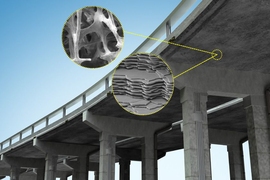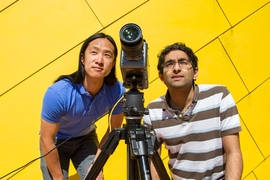By taking an innovative approach to designing recommendations for new buildings and structures, researchers at MIT are collaborating with researchers and engineers around the world to develop cost-effective, non-invasive tools and methods for observing and measuring a structure’s movement and energy, a paradigm referred to as “energy-based design” (EBD).
This summer, Professor Oral Buyukozturk of the Department of Civil and Environmental Engineering (CEE) traveled to Istanbul, Turkey, to direct a workshop on EBD, an emerging structural design and analysis concept.
The energy-based design concept considers earthquake effect as an energy input and looks at how this energy is distributed within the structure. If the structure is damaged, some of this energy would be dissipated. Buyukozturk, his research group, and collaborators from Boğaziçi University and Istanbul Technical University (ITU), are working together to develop tools and methods for observing and measuring a structure’s motion and energy components, in order to have a comprehensive understanding of how the structure would respond to an earthquake. The collaboration is funded by the MIT-Turkey - Boğaziçi University Seed Fund from MIT’s International Science and Technology Initiatives (MISTI), a recent addition to the MISTI Global Seed Funds.
“A design paradigm for earthquake resistance based on this concept is more consistent with the physics of the system and provides more realistic assessment taking into account the duration of the earthquake as opposed to the current design methods that are based on displacements,” Buyukozturk says. “The purpose of the workshop is to advance this concept and verify its potential, through experimentation and analysis also making use of new sensing techniques developed at MIT, for better design of earthquake resilient structures.”
The workshop, called “Energy Based Structural Analysis and Sensing,” provided an open forum for researchers to share their various research and engineering experiences that can be integrated into the EBD paradigm, including sustainable construction materials, structural sensing, and damage detection.
This international research effort between the universities aims to provide a strong basis for new design recommendations and practical codes in enhancing earthquake hazard resistance of modern structures. The meeting, well-versed with participants from local universities and structural design and construction companies, offered ample opportunities for attendees to discuss the emerging paradigm and its potential for earthquake engineering.
“At MIT CEE, our research aims to solve the world’s greatest challenges in the areas of infrastructure and environment, and we collaborate broadly to understand complex issues and offer solutions,” says Markus Buehler, head of CEE and the McAfee Professor of Engineering. “By establishing international collaborations such those formed through Professor Buyukozturk’s Energy Based Structural Analysis and Sensing workshop, we are able to increase the impact of our novel research and developments.”
Strength in numbers: Forming international collaborations
At the workshop, members of Buyukozturk’s group, including postdocs Hao Sun and Justin Chen and graduate students Steven Palkovic, James Long, and Murat Uzun, presented comprehensive findings of their research, including advanced sensing technologies and data processing algorithms. The MIT research team also presented their recent developments on their video-based structural sensing and motion magnification. While in Turkey, the group used this technique to measure the vibration modes of the suspension bridge crossing the Istanbul Bosphorus and connecting Europe to Asia.
“It was a great opportunity to attend the workshop, exchanging ideas with our collaborators in Turkey. This workshop broadens the spectrum for further development of energy based design and analysis approaches through incorporating innovative sensing and data analytics techniques,” says Sun from Buyukozturk’s group. “The Boğaziçi campus venue is one of the most beautiful places in the world overseeing the Istanbul Bosphorus, and the food was incredible.”
Researchers from Boğaziçi and ITU also introduced their ongoing research findings from research on EBD. As a result of the information-sharing, Buyukozturk’s group and researchers from Boğaziçi and ITU were able to identify numerous areas potential for partnering on various related projects with several PhD topics.
“Visiting the two universities in Istanbul really facilitated the exchange of research ideas as well as the unique opportunity to conduct experiments in a world class earthquake structural testing facility,” says Chen.
In addition to research presentations, the workshop included experimental work on a powerful shake table, which simulated actual earthquake motions in shaking selected laboratory structures. In this process, the data acquisition systems used include the novel techniques developed by the MIT team, such as computer vision-based structural sensing. The event concluded with a final session allowing researchers and participants to discuss emerging research and development opportunities and future EBD tools and methods.
“This is a partnership of top institutions with enthusiastic and bright students promising game-changing innovations in the future,” Buyukozturk says.
The data collected during the workshop will be processed by the researchers from MIT, Boğaziçi, and ITU. This continued international collaboration is currently focused on analyzing initial findings, furthering the development of EBD and the eventual publication of their results and recommendations.
“MISTI looks forward to consolidating the MIT-Boğaziçi University collaboration through the next seed fund call, and to expanding the range of student and faculty opportunities it offers in Turkey,” says Serenella Sferza, co-director of the MIT-Italy Program and MIT-Turkey Pilot Program Lead.
The Energy Based Structural Analysis and Sensing event was held as part of a continued workshop series between MIT, Boğaziçi, and ITU. The next workshop is planned to be held at MIT, and Buyukozturk’s group will host collaborators from the Turkish partner universities. The workshop was organized in collaboration with Associate Professor Cem Yalcin of Boğaziçi and Associate Professor Ercan Yuksel of ITU and was made possible by the support and funding from MISTI and Limak Holding of Turkey.












